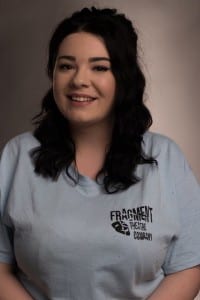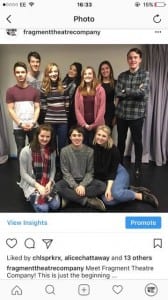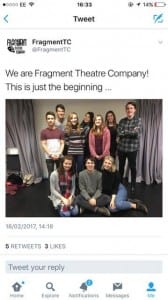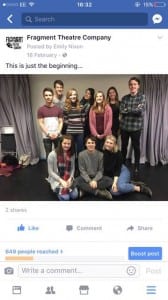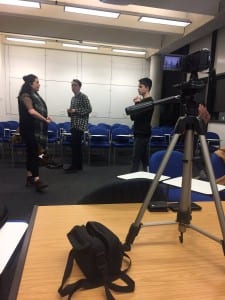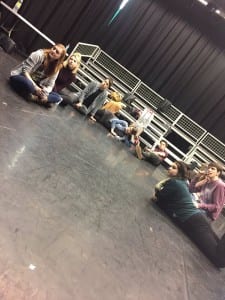During the first few weeks of this module we have begun to create material and themes for our show, which will be based upon escapism. We currently aim to include four sections which will show an array of methods that individuals use to escape from everyday life.
On February 3rd I partook in a workshop with Flick Book Theatre, a company who can be found on their Facebook Page here.
I found this session useful for highlighting various methods of generating material for our show, as our company have decided to generate material during rehearsals to be scripted afterwards, rather than relying on the creation of a script for dramatic influence.
If we proceed with this method of generating material, we will be producing a post-modern piece as ‘[postmodern] theatre is […] characterized through its emphasis on voice and image, rather than on narrative and character, emphasizing the collective and interactive over the individual and self-sufficient text’ (Malkin, 1999, 17). I will undergo further research into post-modern theatre as the process continues if it remains relevant, as being the writer for our theatre company it is important for me to understand how the creative process during rehearsals will influence the way in which the script takes form.
During the workshop with Flick Book Theatre we were prompted to find pages on Wikipedia relevant to the current topics and ideas for our production. This was done to provide us with hyperlinks to correlating or juxtaposing pages which resulted in us having a plethora of ideas and topics on Post-It notes, to explore when continuing the creation of our show.
This slideshow requires JavaScript.
Figures 1 – 3 – Pictures of Post-It Notes in Flick Book’s Workshop (Anthony, 2017)
An exercise which stood out for me as both a writer and actor of our cast included our company writing and subsequently answering questions which ranged from personal to seemingly random ones. I found that the impromptu nature of answering questions provided an enjoyable ‘live’ element to the ‘performance’ we participated in when answering, which I personally wish to replicate in some way when creating our final production.
This slideshow requires JavaScript.
Figures 4 -10 – Pictures of Flick Book’s Workshop (Anthony, 2017)
During the rehearsals and production meetings following the Flick Book Theatre workshop our group has been continued to discuss the ideas for our final performance.
In order to decide upon the content of the four sections of our show, we are all going to bring in stories surrounding how each cast member escapes, for next week’s rehearsals. I believe this method of generating material from our personal experiences will enhance the content of our script by adding the personal connections with the material present.
During this week I have also taken on the role of ‘digital executive’, which means I will be designing and creating the ‘blog’ which these posts will be present on. This production role will also involve editing videos of rehearsals for use on the blog, and providing links to the social media and marketing of our company.
Works Cited:
Malkin, J. R. (1999) Memory-Theatre and Postmodern Drama. Michigan: University of Michigan.
Facebook (2017) ccessed 12 February 2017].
Figures:
Figure 1 – Anthony, R. (2017) Pictures of Post-It Notes in Flick Book’s Workshop. Lincoln.
Figure 2 – Anthony, R. (2017) Pictures of Post-It Notes in Flick Book’s Workshop. Lincoln.
Figure 3 – Anthony, R. (2017) Pictures of Post-It Notes in Flick Book’s Workshop. Lincoln.
Figure 4 – Anthony, R. (2017) Pictures of Flick Book’s Workshop. Lincoln.
Figure 5 – Anthony, R. (2017) Pictures of Flick Book’s Workshop. Lincoln.
Figure 6 – Anthony, R. (2017) Pictures of Flick Book’s Workshop. Lincoln.
Figure 7 – Anthony, R. (2017) Pictures of Flick Book’s Workshop. Lincoln.
Figure 8 – Anthony, R. (2017) Pictures of Flick Book’s Workshop. Lincoln.
Figure 9 – Anthony, R. (2017) Pictures of Flick Book’s Workshop. Lincoln.
Figure 10 – Anthony, R. (2017) Pictures of Flick Book’s Workshop. Lincoln.
